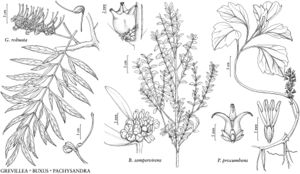Shrubs 1–3(–8) m, glabrous, except puberulent on young shoots, petioles, and basal portion of leaves. Leaves: petiole to 2 mm; blade elliptic to widely elliptic, 1.5–3 × 0.7–1.7 cm, base cuneate, apex obtuse or, occasionally, retuse, surfaces darker green adaxially. Capsules 8 mm diam. Seeds 5–6 mm. 2n = 28.
Phenology: Flowering spring; fruiting late summer–fall.
Habitat: Old homesites, waste places.
Elevation: 0–1000 m.
Distribution
Introduced; N.Y., N.C., Ohio, Pa., R.I., Tenn., Va., W.Va., s, w Europe, sw Asia, nw Africa.
Discussion
The hard, heavy wood of Buxus sempervirens is used for engraving, marquetry, turning, tool handles, mallet heads, and musical instruments. All parts of the plant are toxic if ingested; contact with the plant may cause dermatitis (W. H. Lewis and M. P. F. Elvin-Lewis 1977).
Selected References
None.
Lower Taxa
None.
